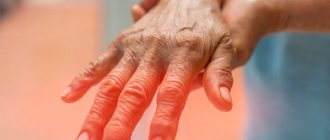Alcoholic polyneuropathy is a dangerous neurological disease. The cause of the formation of pathology is damage to nerve cells by toxic breakdown products of ethanol.
Mostly people who drink alcohol for a long time are susceptible to the disease, so to speak, experienced alcoholics. Rarely, polyneuropathy can occur in individuals who have experienced acute alcohol intoxication.
Withdrawal from binge drinking, coding and treatment of alcoholism. Departure of a narcologist to any city in Russia. Anonymous drug treatment assistance. Call now!
Ethanol breakdown products have a negative effect on nerve cells of the peripheral nervous system. The result is:
- Tissue destruction
- Movement disorders
- Cognitive impairment
- The limbs begin to feel worse
People suffering from polyneuropathy begin to walk in a special way; their gait is usually called “alcoholic.” Such patients, even when sober, walk staggering.
Content:
- The essence of the disease
- Reasons for the formation of pathology
- Classification
- Alcoholic polyneuropathy, symptoms, diagnosis
- Alcoholic polyneuropathy, treatment
Chronic intoxication with alcoholic beverages leads to the development of many diseases. Often, people suffering from alcoholism develop alcoholic polyneuropathy (polyneuritis), a disease in which complaints appear that indicate damage to the structures of the peripheral nervous system. Its obvious signs are detected in 20-30% of alcoholics. Pathology occurs 5 times more often than manifestations of central nervous system disorders. Hidden (latent) forms of the disease are characteristic of almost all patients. But they can only be noticed when examined using special methods, in particular – electroneuromyography. Men suffer several times more often than women. You can find out more about what this problem is and how it manifests itself in the symptom description section.
Prognosis for recovery
If you promptly seek qualified medical help, polyneuropathy can be defeated. Most importantly, the patient must completely abstain from alcohol and follow all the doctor’s recommendations. The patient must be patient; treatment of the pathology can be long.
Refusal of treatment or continued use of alcohol can lead to:
- Paralysis
- Disabilities
- Fatal outcome
The danger of alcoholic polyneuropathy cannot be underestimated. It is important to seek medical help when you notice the first symptoms. Braking in such a matter can cause very sad consequences.
The essence of the disease
Pathological disorders consist in the destruction of the structures of the peripheral nervous system under the influence of toxic substances - the breakdown products of ethanol. Long-term exposure to alcohol leads to the destruction of neurons and their processes - axons. Alcohol also destroys vitamins and causes vitamin deficiency. Deficiency of thiamine and nicotinic acid is especially negative. Damaged tissue of peripheral nerve fibers and failure of metabolic processes cause specific sensations and symptoms of polyneuropathy.
How it develops
Polyneuropathy manifests itself from the very beginning of alcohol dependence, gradually transforms into more severe forms and is accompanied by mental disorders. This is multiple diffuse damage to nerve fibers in the peripheral nerves.
Statistics report that polyneuropathy is observed in 80-100% of cases of alcohol dependence. In mild forms it is expressed by mild tingling and numbness of the legs, in severe forms – difficulty breathing, problems with the cardiovascular system, and the inability to move independently. The process can take 10 years and in half of the cases ends in death.
Reasons for the formation of pathology
Obvious signs of the disease make themselves felt in cases of advanced alcoholism. They are detected in patients with stages II and III of chronic alcohol dependence.
Causal factors leading to alcoholic polyneuropathy:
- Toxic demyelination of neuronal axons.
- Avitaminosis.
- Accumulation of acetaldehydes in the blood.
Low-quality alcohol, denatured alcohols, and non-edible liquids containing ethanol have a particularly destructive effect. Sometimes one dose of a toxic substance is enough to form polyneuritis. Hereditary deficiency of enzymes that neutralize the products of ethanol catabolism in the liver is also important.
- The process gets worse:
- Thiamine (vitamin B1) deficiency.
- Poor nutrition, due to lack of appetite during binge drinking, financial difficulties of an alcoholic who prefers to buy alcohol rather than normal food.
- Violation of the detoxification function of the liver.
Diagnostic methods
It will be quite difficult to initially make a correct diagnosis, because the symptoms of polyneuropathy are similar to other diseases. And making a diagnosis by listening to the patient’s complaints is almost impossible, because it is necessary to undergo a whole series of laboratory tests.
First of all, you need to thoroughly consult with a neurologist so that the specialist examines the limbs that are affected, and he also needs to check the patient’s reflexes.
When there is already an approximate suspicion of polyneuropathy, then it will be necessary to conduct a general blood test, do an electroneuromyography, and in very rare cases a nerve biopsy will be needed.
ENMG will make it possible to find out about nerve damage, a differential diagnosis of other diseases will be made, and it will be possible to determine the prognosis of this disease. And then ENMG will allow you to track the dynamics of changes in the nerves against the background of the rest of the treatment.
The next stage is the laboratory methods of the entire study, namely screening laboratory tests. In other cases, there is a need to consult an endocrinologist, as well as do other research.
Classification
Alcoholic polyneuropathy has several clinical variants.
The following forms are distinguished along the flow:
- spicy;
- subacute;
- chronic.
Acute is provoked by binge drinking or hypothermia. Against this background, symptoms manifest quickly and, without treatment, become latent, or a protracted version with erased manifestations.
The chronic form develops in 4 stages:
- Zero. It is possible to identify changes indicating the onset of a disease process only through studies using a special diagnostic device - an electromyograph. Positive data from quantitative and sensory testing also support the development of pathology. The patient does not make any complaints.
- The first (initial manifestations). The patient experiences periodic, mild symptoms of polyneuritis.
- The second (with classic, clinically significant signs). For diagnosis, existing complaints and medical examination data are quite sufficient. There are no functional defects.
- Third (with severe symptoms). Patients who are sick partially or completely lose their ability to work and become disabled.
Prevention
Preventive measures are as follows:
- Diet - good nutrition - is the basis for successful recovery of the body.
- Refusal of alcohol. Abstaining from drinking alcohol will help ensure that medications and treatments are effective, otherwise treatment may not need to be started.
- Timely treatment of systemic and infectious diseases.
- Spa treatment.
The likelihood of developing a poor prognosis is always associated with alcohol abuse and ongoing poor nutrition of the dependent person.
Alcoholic polyneuropathy, symptoms, diagnosis
The first manifestations of the disease are numerous unpleasant sensations.
Patients complain of:
- "Goosebumps" on the skin.
- Numbness and tingling of the skin.
- Feeling of muscle tightening.
Most often, the process begins with the legs - alcoholic polyneuropathy of the lower extremities. Patients feel as if they have “sat” in an uncomfortable position or “rested” their leg. Few people pay attention to these troubles. Over time, symptoms increase.
Patients develop:
- Pains of a pulling, stabbing, burning nature.
- Weakness of the extremities, “wobbly legs.”
- Tonic spasms “cramp the muscles.”
- Sensitivity disorders: deep, temperature, pain.
- Paresis of skeletal muscles.
Periodic sensations (paresthesias) become constant and spread from distant areas (distal) to those located closer to the body (proximal). Patients feel as if they are wearing socks and gloves on their hands and feet, and when walking, the illusion of moving “on a cushion of air” occurs. Losing sensitivity leads to loss of normal perception of objects by touch. The intensity of the development of symptoms can be lightning fast or slow (over months and years).
Advanced stages cause:
- Increasing muscle weakness while maintaining the principle of upward propagation of the process. Against this background, the manifestations of paresthesia are softened.
- Involvement of not only the lower but also the upper extremities.
- Loss of vibratory sensitivity, muscle-joint feeling.
- Paralysis (in severe form).
When examining a patient, the doctor reveals:
- A sharp decrease (in 80-90% of cases), or complete absence of Achilles reflexes, in 50% of patients – knee reflexes.
- Atrophic changes in the muscles of the legs with transition to the thighs.
- Dysfunction of the foot extensors. In this situation, a person’s gait changes. Sometimes there is a failure of coordinated muscle movements - ataxia.
- Neurotrophic problems: increased sweating (hyperhidrosis), marbled skin color, swelling.
A number of specialists in their practice distinguish the following forms of polyneuritis:
- Motor, with a predominance of complaints in changes in movement functions.
- Sensitive, in which the clinic of sensitivity disorders dominates.
- Ataxic, manifested by movement coordination disorders.
- Mixed.
Diagnostics include:
- Survey.
- Inspection.
- Electromyography.
Some doctors identify, along with polyneuropathic symptoms, organic types of central nervous system damage such as:
- Disseminated encephalomyelitis.
- Hypothalamic syndrome.
- Vegetative-vascular paroxysms.
- Mononeuritis.
- Pseudotabetic syndrome.
An electromyogram allows you to detect hidden problems and clarify the features of an existing lesion. If necessary, histological electron microscopy is performed.
It makes it possible to identify two types of damage to nerve fibers:
- Axon destruction.
- Damage to the membranes of the processes (demyelination).
The disease can last for years. The prognosis depends on how advanced the process was initially before treatment.
Symptoms
A person in a state of alcoholic intoxication does not pay attention to the first alarming symptoms: pain in the legs, muscle weakness, mild numbness. Moreover, they begin to appear from the very beginning of alcohol dependence. Gradually the symptoms become extensive:
- • convulsions appear;
- • fingers and hands become numb;
- • the sensitivity of the legs is impaired - the symptom is described as “woolly” or “soft” legs that do not support their owner;
- • tendon reflexes decrease;
- • incomplete and complete paralysis of the legs is diagnosed (in the severe stage);
- • shins and feet become bluish and cold;
- • pigmentation and trophic ulcers are formed;
- • muscle atrophy occurs.
At first, symptoms affect only the legs, but gradually spread to the whole body. In the later stages, mental disorders begin: memory loss, impaired speech function, sudden mood swings, manic states, disorientation.
The greater the damage, the more pronounced atoxic lesions appear, which, together with impaired tendon reflexes, resemble late neurosyphilis.
Hyperhidrosis, edema, disruption of the nerves of the skull - all these are consequences of the disease.
Alcoholic polyneuropathy, treatment
For recovery, complete abstinence from alcohol is necessary. In addition to the sobriety regime, it is important to establish adequate nutrition for the patient.
The diet should contain:
- High protein foods.
- A variety of fruits containing a complex of essential vitamins, especially group B.
- Dairy products, cheese, eggs.
You should avoid fried, smoked and canned foods.
Drug therapy includes the following drugs:
- Analgesics for pain relief.
- Anticonvulsants for seizures.
- Antidepressants for mental problems.
- Improving microcirculation in blood vessels.
- Regulating nerve conduction.
- Antioxidants.
- Antihypoxants.
- Multivitamins.
During the rehabilitation period the following is prescribed:
- Therapeutic exercise that strengthens the musculoskeletal system.
- Massage for the prevention of contractures.
- Kinesiotherapy promotes stretching of ligaments and muscles, increasing the range of motion in the joints.
- Acupuncture.
Drug and physiotherapeutic treatment of polyneuritis is complemented by a course of anti-alcohol treatment followed by coding.
A psychotherapist eliminates mental problems with the help of:
- Rational methods of individual psychotherapy.
- Hypnosis.
- Special psychocorrection programs.
Alcoholic polyneuropathy can last for years. The prognosis depends on how timely the request for help was. Of no small importance is the patient’s disposition to completely abstain from drinking alcohol. After completing a course of therapy and following all medical recommendations, the symptoms gradually reduce. Functionality is restored partially or completely.
Toxic polyneuropathies (information for patients and doctors)
Toxic polyneuropathy (information for patients and doctors) Alcoholic polyneuropathy
What is Alcoholic Polyneuropathy? “Alcoholic polyneuropathy” is a consequence of the direct toxic effect of ethanol and its metabolites on peripheral nerves with predominant damage to thin, weakly myelinated and unmyelinated fibers that conduct pain, temperature sensitivity and provide autonomic-trophic functions.
How common is this disease among the Russian population? In Russia, according to official data, about 5% of the population over the age of 18 abuses alcohol, which is about 7.5 million people. According to the WHO report, in 2021 our country was in fourth place in terms of the amount of alcohol consumed per capita (13.9 liters of pure alcohol per year), behind Lithuania, Belarus and Moldova. At the same time, in Russia they often drink strong alcoholic drinks, while in other European countries preference is given to beer and wine. In relation to polyneuropathies of other origins, the proportion of alcoholic damage to peripheral nerves is about 40%. According to the literature, 76% of patients suffering from alcohol dependence for more than 5 years have clear clinical signs of alcoholic polyneuropathy; At the same time, subclinical (“erased”, “hidden”) nerve damage according to electroneuromyography (ENMG) is detected in 97–100% of patients who chronically drink alcohol, that is, in the vast majority.
How do I know if I drink a lot of alcohol? The GAGE questionnaire will help answer this question. Answer the questions unequivocally “YES” or “NO” in the way you understand them. If you have difficulty answering, do not answer anything:
- Have you ever felt that you should cut down on your drinking?
- Did you feel irritated if someone around you (friends, relatives) told you about the need to reduce your drinking?
- Have you ever felt guilty about drinking alcohol?
- did you have the desire to drink alcohol as soon as you woke up after drinking alcoholic beverages?
Interpretation of results: for each answer “YES” - 1 point. A score of 2 or more points corresponds to SIGNIFICANT ALCOHOL ABUSE. You need to reconsider your lifestyle and eliminate the harmful effects of the toxic effects of alcohol on the body, in particular polyneuropathy. Yes, I scored more than 2 points, but what symptoms bother patients with alcoholic polyneuropathy? The first signs of the disease may not be immediately noticed by patients, since this type of polyneuropathy is characterized by a slow progression of symptoms over several years. Less commonly, the clinic can develop acutely, during or after a binge.
Depending on which nerve fibers are more involved in the pathological process, the following characteristic complaints arise:
- sensitive symptoms: numbness, tingling, “burning”, “burning”, pain, “crawling” in the feet, legs, and later in the hands; decreased sensitivity in the feet - “I don’t feel like I’m putting on shoes, I don’t feel the floor”; unsteadiness when walking, worse in the dark and with eyes closed;
- motor symptoms: weakness develops in the muscles of the feet and legs, then weakness in the muscles of the hands may develop (impaired fine motor skills); difficulty walking, “spanking” of the feet;
- autonomic symptoms: fluctuations in blood pressure; “interruptions” in the work of the heart; constipation, diarrhea; dry skin or sweating; erectile dysfunction and decreased libido;
- symptoms of concomitant damage to the central nervous system: memory impairment; confusion; decreased intelligence; disorientation; indifference to loved ones and others; inattention; drowsiness.
The clinical picture and “set” of symptoms may vary. In 42% of those diagnosed with alcoholic polyneuropathy, neuropathic pain syndrome is detected.
Are there risk factors for developing this disease? There definitely is! The most important factor is the frequency of alcohol consumption. There are 3 cohorts of patients who abuse alcohol: occasional drinkers (a period of sobriety of more than 5 days, without binge drinking), frequent drinkers (drinking alcohol more than 3 times a week with a hangover more than 1 time a week) and constant drinkers (daily drinking, without sobriety) . It was found that patients from the groups of “frequent drinkers” and “constant drinkers” have higher rates of detection of polyneuropathy (29.6% and 29.9%, respectively) than the group of patients “occasional drinkers” (11.3%). Subjective polyneuritic symptoms developed after a relatively short duration of abuse (1-5 years), and signs of severe polyneuropathy developed after alcohol abuse for more than 10 years. Female gender increases the risk of developing more severe polyneuropathy. Such gender differences are due to a higher rate of absorption of alcohol and, as a consequence, a higher level of alcohol in the blood in women than in men. Women's addiction and full-fledged dependence on alcohol develop much faster than in men. If in men chronic alcoholism (first-second stage) develops after 6-12 months of daily drinking, then for women 3-6 months are enough. The genetic risk factor manifests itself, first of all, in a hereditary craving for alcohol, which can, from generation to generation, lead to the development of alcoholic polyneuropathy and damage to other organs and systems. Malnutrition and B vitamin deficiency often accompany alcohol abuse. It has been proven that ethanol reduces the absorption of vitamins in the small intestine, reduces their “liver” reserves, and disrupts the processes of phosphorylation and the formation of active forms of vitamins. Deficiency of B vitamins is an additional cause of peripheral nerve damage, which, together with the toxic effects of alcohol, aggravates the course of polyneuropathy. Impaired liver function is caused by a long period of alcohol intake or the addition of other concomitant diseases. As a result, fatty hepatosis occurs, which over time can transform into alcoholic hepatitis and cirrhosis of the liver. Liver failure is a separate cause of damage to peripheral nerves, and when caused by alcohol, it leads to severe polyneuropathy.
What type of alcohol increases the risk of developing polyneuropathy? Any type of alcohol contains ethanol and its metabolites, mainly acetaldehyde, which has a direct toxic effect on peripheral nerves. Scientists from the Maugeri Medical Detoxification Center conducted a comparative analysis of alcoholic beverages consumed by their patients. It was found that drinking wine, compared to drinking beer, causes a greater risk of developing polyneuropathy. This may be due to the presence of impurities that wine producers add to their product. No other comparative studies have been conducted on this topic.
What is the mechanism of nerve damage caused by alcohol consumption? Alcohol enters the bloodstream within 5 minutes of ingestion and reaches its peak after 30–90 minutes. Ethanol and its toxic metabolites affect the functioning of neurons. Free oxygen radicals disrupt the function of cellular structures, primarily the vascular endothelium, causing endoneurial hypoxia and leading to damage to nerve axons. In addition, ethanol reduces the synthesis and disrupts the normal configuration of nerve fiber cytoskeletal proteins and slows down axonal transport.
On what basis did the doctor diagnose “Alcoholic polyneuropathy”? The key to making a diagnosis is a history of systematic or binge drinking of alcohol, the absence of anamnestic and clinical and laboratory signs of other probable causes of polyneuropathy: diabetic, hereditary, dysimmune, etc. To confirm the diagnosis and exclude alternative causes of polyneuropathy, the doctor may order the following tests:
- electroneuromyography, which allows you to assess the functional state of motor and sensory fibers of peripheral nerves and determine the nature of their damage;
- general blood analysis;
- detailed biochemical blood test;
- glycated hemoglobin and glucose tolerance test;
- blood test for HIV, RW, hepatitis B and C;
- blood test for levels of vitamins B1, B6, B9, B12, homocysteine;
- rheumatic tests (rheumatic factor, antineuronal antibodies ANCA, antinuclear factor, antibodies to nuclear antigens ANA, antibodies to cyclic citrullinated peptide, antinuclear antibodies, etc.);
- antineuronal antibodies (anti-Hu, anti-CV2/CRMP-5).
- electrophoresis of serum and urine proteins with immunofixation + freelite.
To diagnose polyneuropathy with predominant damage to thin, weakly myelinated nerve fibers, additional research methods are used:
- cardiovascular tests, assessment of heart rate variability, tilt test;
- autonomic evoked potentials;
- corneal confocal microscopy;
- quantitative sensory testing;
- punch skin biopsy with assessment of the condition of intraepidermal thin nerve fibers.
What treatment can a neurologist prescribe? The main and main stage of treatment is a complete cessation of drinking alcohol. Observation by a narcologist will be useful. Pathogenetic therapy for alcoholic polyneuropathy has not yet been developed. A nutritious, balanced diet with sufficient amounts of vitamins and protein and other lifestyle changes (quitting smoking, normalizing body weight) themselves contribute to a significant improvement in the condition of patients with alcohol-related illness. In cases of concomitant deficiency of B vitamins, vitamins B1 (thiamine), B6 (pyridoxine), B9 (folic acid), B12 (cyanocobalamin) are prescribed. In the presence of neuropathic pain syndrome, medications are prescribed according to the symptoms of its correction: antidepressants (amitriptyline, duloxetine, venlafaxine) and anticonvulsants (gabapentin, pregabalin). Restorative and rehabilitation methods of treatment (transcutaneous electrical neurostimulation, myostimulation, acupuncture, biofeedback, massage, physiotherapy, balance therapy, robotic therapy) occupy an important place in the correction of polyneuritic disorders. If you have symptoms of polyneuropathy and you scored 2 or more points on the GAGE questionnaire, then you urgently need to seek specialized medical care at the Center for Diseases of the Peripheral Nervous System of the Federal State Budgetary Institution National Center for Neuroscience!
Drug-induced and chemotherapy-induced polyneuropathy What do these terms mean? Drug-induced polyneuropathy is multiple, diffuse, uniform and symmetrical damage to peripheral nerves that develops while taking a drug with a high and moderate degree of neurotoxicity. Chemotherapy-induced polyneuropathy that develops during or after chemotherapy is considered separately.
How common is this disease? The prevalence of all drug-induced polyneuropathies has not been reliably determined. At the same time, the prevalence of polyneuropathy among cancer patients receiving chemotherapy is 77.2%. In approximately 1/3 of patients, symptoms persist for at least 6 months after completion of chemotherapy. In addition, the severity of polyneuropathy may limit the continued use of adequate dosing of drugs, potentially increasing morbidity and risk of death from cancer.
What drugs can contribute to the development of this disease? The following is a partial list of drugs with high and moderate neurotoxicity: Vitamins: • pyridoxine (B6) • niacin (B3) Immunosuppressants: • chloroquine • gold salt drugs • leflunomide • cyclosporine Cardiovascular drugs: • amiodarone • procainamide • captopril • hydralazine Antimicrobials: • metronidazole • nitrofurans • chloramphenicol • fluoroquinolones • streptomycin Statins: • atorvastatin • lovastatin • pravastatin Psychotropic drugs: • amitriptyline • lithium salts • amphetamines Antihistamines: • cimetidine NSAIDs: • indomethacin Antigout drugs: • colchicine • allopurinol Chemotherapy drugs: • platinum-based drugs: cisplatin, carboplatin, oxaliplatin • taxane-containing drugs: paclitaxel, abraxane, docetaxel • thalidomide and its analogues: lenalidomide, revlimid, methiblastane • vinca alkaloids: vincristine, vinblastine, vinorelbine, vindesine Anesthetics: • nitrous oxide Anti-alcohol drugs: • disulfiram
IMPORTANT ! The connection between taking a drug from this list and the development of polyneuropathy can only be established by a DOCTOR! Independent withdrawal of the drug is NOT ALLOWED! Your goal is to warn your attending neurologist about taking medications from this list if you have characteristic polyneuritic complaints!
What symptoms bother patients with these types of polyneuropathies? Symptoms for drug-induced and chemotherapy-induced polyneuropathy are absolutely the same as for alcoholic polyneuropathy (see above). At the same time, the symptoms of polyneuropathy can be extremely variable, which is associated with the individual response of nerve fibers to the damaging effects of drugs and chemotherapy.
How quickly does polyneuropathy develop when taking a neurotoxic drug? If we talk about drugs that do not belong to the group of chemotherapy, then the first symptoms of neurological disorders may appear after a long time from the start of taking it. Patients often do not see the connection and attribute their complaints to other possible causes and lifestyle changes. We see a different picture after a course of chemotherapy, when symptoms can increase quite quickly after just 1 course of treatment. But the development of symptoms may be delayed, 3-6 months after the end of the entire course of chemotherapy.
On what basis did I receive this diagnosis? The key to making a diagnosis is the presence of polyneuritic complaints and symptoms revealed during examination, as well as a history of constant or systematic use of a drug from a risk group or chemotherapy including drugs with moderate and high neurotoxicity. It is important that there are no anamnestic and clinical laboratory signs of other probable causes of polyneuropathy, including a negative family history. One of the criteria for the correctness of the established diagnosis includes improvement of the condition, or stopping the progression of the disease against the background of therapy. To confirm the diagnosis and exclude alternative causes of polyneuropathy, the doctor may prescribe the studies listed above, including electroneuromyography, which allows you to assess the functional state of the motor and sensory fibers of the peripheral nerves and determine the nature of their damage.
What treatment options are there? After the diagnosis is made, together with specialized specialists, drug therapy is reviewed: the “neurotoxic” drug is replaced with another one. If necessary, symptomatic therapy for neuropathic pain syndrome (antidepressants, anticonvulsants) is prescribed. Prescribing “neurometabolic” drugs is not advisable due to the lack of evidence. Restorative and rehabilitation treatment is important in the correction of neurological disorders in polyneuropathy: transcutaneous electrical neurostimulation, acupuncture, biofeedback, interventional methods, massage, physiotherapy, balance therapy, robotic therapy. But we must remember that some methods are contraindicated in the presence of a concomitant history of cancer.
What are the prognosis for this disease? Life expectancy does not differ from that of people who do not have this disease. Recovery depends on the course of the underlying disease for which the “neurotoxic” drug is prescribed. It is extremely important for the prognosis to make a timely correct diagnosis, drug treatment and careful monitoring of the patient.
If you have symptoms of polyneuropathy and are taking “neurotoxic” drugs, then you urgently need to seek specialized medical care at the Center for Diseases of the Peripheral Nervous System of the Federal State Budgetary Institution National Center for Neuroscience.
Employees of the Center for Peripheral Nervous System Diseases provide consultations to patients on an outpatient basis within the framework of compulsory medical insurance and on a commercial basis.
MAKING AN APPOINTMENT AND ENMG/iEMG BY MULTI-CHANNEL PHONE +7 +7
Literature:
- Guide to neurology according to Adams and Victor: textbook. manual for the postgraduate system. prof. physician education / Maurice Victor, Allan H. Ropper; scientific ed. V. A. Parfenov; lane from English edited by N. N. Yakhno. — 7th ed. — Moscow: Med. information agency, 2006. - 677 p.
- Peripheral nervous system in normal and pathological conditions: [educational manual] / N. S. Subbotina; Federal Agency for Education, State. higher educational institution prof. Education Petrozavodsk State univ. - Petrozavodsk: PetrSU Publishing House, 2006. - 129 p.
- Classical neurology: a guide to the peripheral nervous system and chronic pain syndromes / Silantiev Konstantin. - Volgograd: Panorama, 2006 (Volzhsky: Alliance Yugpoligraphkombinat, Volzhsky polygraphkombinat). — 399 p.
The text was checked by expert doctors: Head of the socio-psychological service of the Alkoklinik MC, psychologist Yu.P. Baranova, L.A. Serova, a psychiatrist-narcologist.
CAN'T FIND THE ANSWER?
Consult a specialist
Or call: +7 (495) 798-30-80
Call! We work around the clock!
Diagnosis of the disease
The earlier the disease is detected, the faster specialists will be able to determine the form of the disease and prescribe medications to alleviate the patient’s condition. Treatment of alcoholic polyneuropathy of the upper extremities or legs is not prescribed without conducting a study of bioelectric potentials. This procedure is called ENMG (electroneuromyography). Its disadvantage is the use of the technique only in the early stages of the disease.
When the disease has already progressed, electroneuromyography alone is not enough. Here, doctors must use nerve fiber biopsy, that is, cell sampling for a comprehensive diagnosis. Plus, specialists conduct an external examination and collect anamnesis. A combination of modern research methods makes it possible to accurately determine the form of the disease and the severity of damage.










